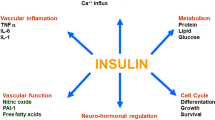Abstract
Background
Renal complications in acromegaly include glomerular hyperfiltration, insulin resistance, hypercalciuria and urolithiasis. The aim of this study was to investigate whether urinary calcium (UCa) excretion is a direct consequence of growth hormone secretion or secondary to hyperfiltration and/or insulin resistance.
Methods
We performed a cross-sectional study of 58 patients diagnosed with acromegaly. Demographic data were obtained, serum analysis was performed, including insulin-like growth factor (IGF)-1, and 24-h urine collection, to measure urinary protein excretion, UCa and phosphate excretion, as well as fractional excretion of sodium and potassium. We also calculated the homeostasis model assessment of insulin resistance (HOMA-IR).
Results
Patients were predominantly male (60.3%), and their mean age was 45.9 ± 14 years. Hypercalciuria was present in 24% of patients. Patients with higher HOMA-IR had higher IGF-1 levels, a trend toward higher body mass index and higher UCa excretion. In univariate analysis, UCa excretion was associated with HOMA-IR (r = 0.472, P = 0.001), phosphaturia (r = 0.457, P = 0.001), IGF-1 (r = 0.398, P = 0.002) and creatinine clearance (r = 0.394, P = 0.001). HOMA-IR and phosphaturia were independently associated with UCa excretion. No independent associations were found between phosphaturia and HOMA-IR or IGF-1.
Conclusions
The present study revealed an association between hypercalciuria and insulin resistance in patients with acromegaly. Further studies are required to fully understand the pathogenesis of these abnormalities in patients with acromegaly.

Similar content being viewed by others
References
Taboada GF, van Haute FR, Corrêa LL et al (2005) Etiologic aspects and management of acromegaly. Arq Bras Endocrinol Metabol. 49:626–640
Donangelo I, Une K, Gadelha M (2003) Diagnóstico e tratamento da acromegalia no Brasil. Arq Bras Endocrinol Metab. 47:331–346
de Gennes, Bricaire H, Tourneur R, et al. (1961) Renal lithiasis in an acromegalic patient. Role of somatotropic hormone in the mechanism of hypercalciuria. J Urol Nephrol (Paris) 67:75–77
Auriemma RS, Galdiero M, De Martino MC et al (2010) The kidney in acromegaly: renal structure and function in patients with acromegaly during active disease and 1 year after disease remission. Eur J Endocrinol 162:1035–1042
Kamenicky P, Viengchareun S, Blanchard A et al (2008) Epithelial sodium channel is a key mediator of growth hormone-induced sodium retention in acromegaly. Endocrinology. 149:3294–3305
Heilberg IP, Czepielewski MA, Ajzen H et al (1991) Metabolic factors for urolithiasis in acromegalic patients. Braz J Med Biol Res 24:687–696
Parkinson C, Kassem M, Heickendorff L et al (2003) Pegvisomant-induced serum insulin-like growth factor-I normalization in patients with acromegaly returns elevated markers of bone turnover to normal. J Clin Endocrinol Metab 88:5650–5655
Iba A, Kohjimoto Y, Mori T et al (2010) Insulin resistance increases the risk of urinary stone formation in a rat model of metabolic syndrome. BJU Int. 106:1550–1554
Giustina A, Chanson P, Bronstein MD et al (2010) A consensus on criteria for cure of acromegaly. J Clin Endocrinol Metab 95:3141–3148
Whitney JE, Bennett LL, Li CH (1952) Reduction of urinary sodium and potassium produced by hypophyseal growth hormone in normal female rats. Proc Soc Exp Biol Med 79:584–587
Hansen TK, Møller J, Thomsen K et al (2001) Effects of growth hormone on renal tubular handling of sodium in healthy humans. Am J Physiol Endocrinol Metab. 281:E1326–E1332
Ho KY, Weissberger AJ (1990) The antinatriuretic action of biosynthetic human growth hormone in man involves activation of the renin-angiotensin system. Metabolism. 39:133–137
Sakhaee K (2009) Recent advances in the pathophysiology of nephrolithiasis. Kidney Int 75:585–595
Rendina D, De Filippo G, Zampa G et al (2011) Characteristic clinical and biochemical profile of recurrent calcium-oxalate nephrolithiasis in patients with metabolic syndrome. Nephrol Dial Transplant 26:2256–2263
Kohjimoto Y, Iba A, Sasaki Y, Hara I (2011) Metabolic syndrome and nephrolithiasis. Hinyokika Kiyo. 57:43–47
Mazziotti G, Floriani I, Bonadonna S et al (2009) Effects of somatostatin analogs on glucose homeostasis: a metaanalysis of acromegaly studies. J Clin Endocrinol Metab 94:1500
Author information
Authors and Affiliations
Corresponding author
Rights and permissions
About this article
Cite this article
Libório, A.B., Figueiredo, P.R.L., Montenegro Junior, R.M. et al. Urinary calcium excretion and insulin resistance in patients with acromegaly. Int Urol Nephrol 44, 1473–1477 (2012). https://doi.org/10.1007/s11255-011-0116-6
Received:
Accepted:
Published:
Issue Date:
DOI: https://doi.org/10.1007/s11255-011-0116-6




